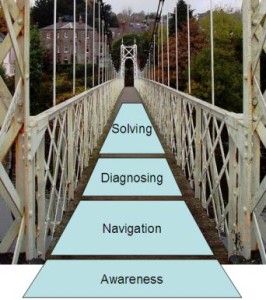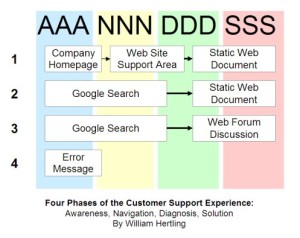
A few weeks ago, I posted about a framework for considering the customer support experience. The framework is composed of four phases: awareness, navigation, diagnosing, and solving.
Pete Hwang, a collegeue of mine, asked if the framework could be shortcut by people using Google:
Framework makes sense. But could you argue that web savvy customers who start with a Google search shortcut the whole thing? The customer experience journey in this case: Customer recognizes they have a problem. Google for error code or best guess at describing problem. View hits on possible solutions… Corroborate entries and take educated guess at likely best solution. Hopefully, solve problem. Otherwise, look toward 2nd most likely answer. If still not solved, try a fresh google search with fresh search terms. The official HP support doc only comes into play as it receives high credibility (high ranking) on Google.
Pete’s point is certainly valid. The framework isn’t intended to dictate a specific support path down which the customer is forced, but instead is a thinking aide to understand their experience and compare the role that different tools play. The way that we’ve used the framework is by describing different support tools within an “AAA NNN DDD SSS” diagram. The letters stand for Awareness, Navigation, Diagnosis, Solution. We repeat the letters simply to remind ourselves that frequently there may be multiple steps within each phase, and that different tools may help get the customer through different phases.
Let’s look at an example. In the picture, row 1 shows what most company’s idealized view of the web support experience looks like. In this idealized picture, the customer thinks first of the company’s web site, enters through the home page, navigates through the site using links, and ultimately finds a web document to solve their problem.
Row 2 shows a common alternative, and the one described by Pete. A customer does a Google search on a product, and again in the ideal world, the Google search’s first result is a link to the support document for that problem.
Row 3 is another alternative – a Google search leads to a web forum discussion. Web forums frequently do exceptionally well in search engine results, so if a forum exists, and the problem has previously been posted, odds are good that a forum result will be high up in the search results.
Row 4 is just a hint of another tool that companies have at their disposal, but frequently don’t take full advantage of. Error messages displayed by software applications or even hardware devices do much to make the customer aware of the problem, but usually do very little to help them find a solution. An error message that was linked back to a support document would directly make the link from problem to solution, and would bypass the need for navigation and diagnosis.
Please let me know if you make use of this framework. I hope it will be of use to you.






